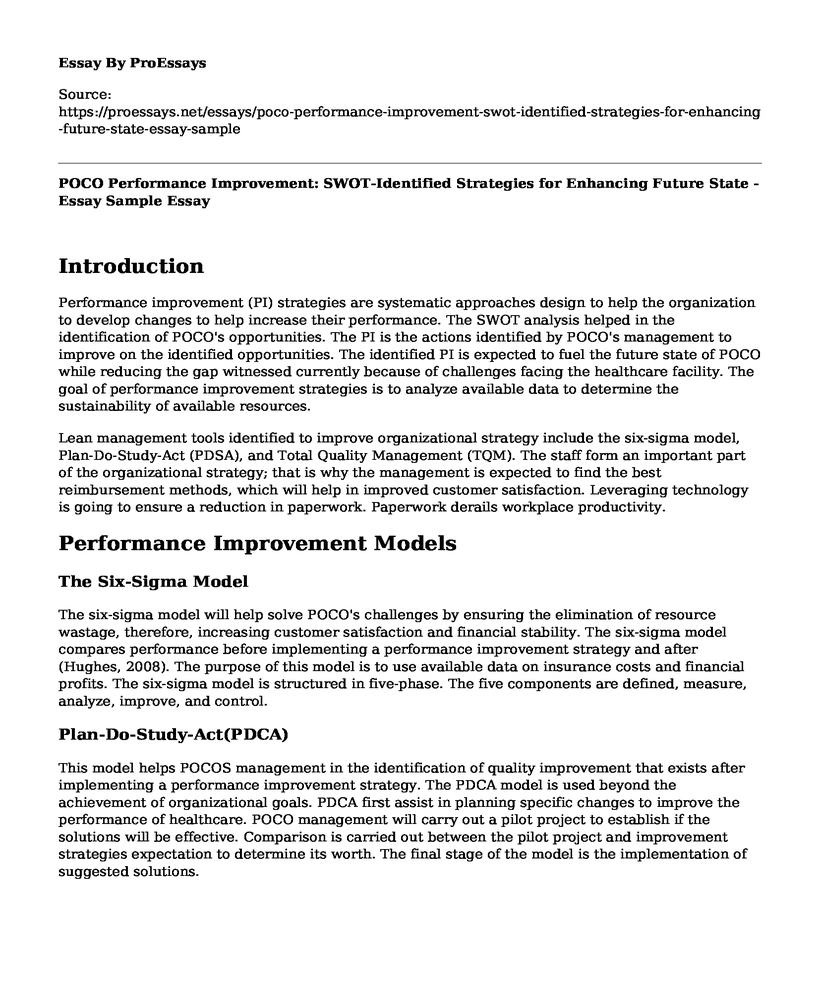Introduction
Performance improvement (PI) strategies are systematic approaches design to help the organization to develop changes to help increase their performance. The SWOT analysis helped in the identification of POCO's opportunities. The PI is the actions identified by POCO's management to improve on the identified opportunities. The identified PI is expected to fuel the future state of POCO while reducing the gap witnessed currently because of challenges facing the healthcare facility. The goal of performance improvement strategies is to analyze available data to determine the sustainability of available resources.
Lean management tools identified to improve organizational strategy include the six-sigma model, Plan-Do-Study-Act (PDSA), and Total Quality Management (TQM). The staff form an important part of the organizational strategy; that is why the management is expected to find the best reimbursement methods, which will help in improved customer satisfaction. Leveraging technology is going to ensure a reduction in paperwork. Paperwork derails workplace productivity.
Performance Improvement Models
The Six-Sigma Model
The six-sigma model will help solve POCO's challenges by ensuring the elimination of resource wastage, therefore, increasing customer satisfaction and financial stability. The six-sigma model compares performance before implementing a performance improvement strategy and after (Hughes, 2008). The purpose of this model is to use available data on insurance costs and financial profits. The six-sigma model is structured in five-phase. The five components are defined, measure, analyze, improve, and control.
Plan-Do-Study-Act(PDCA)
This model helps POCOS management in the identification of quality improvement that exists after implementing a performance improvement strategy. The PDCA model is used beyond the achievement of organizational goals. PDCA first assist in planning specific changes to improve the performance of healthcare. POCO management will carry out a pilot project to establish if the solutions will be effective. Comparison is carried out between the pilot project and improvement strategies expectation to determine its worth. The final stage of the model is the implementation of suggested solutions.
Total Quality Management
The total quality management model helps POCO to achieve its strategic goals from a management point of view. The management is key stakeholders who ensure that organizational goals are achieved. POCO's employees are expected to work together in a defined process, making sure that the strive to create a change that will eventually help the organization to achieve their identified goals (Champagne-Langabeer & Delgado, 2018).
Review of PI model
The SWOT analysis tool kit helps the management of POCO to review the performance of PI models identified. Below is a summary of POCO's performance improvement strategies.
Strengths
POCO's team is comprised of a competent workforce. The company's image is reputable despite a drop in customer satisfaction. The top management is effective; therefore, there is confidence in them to help POCO achieve the identified goals.
Weakness
There is a high increase in the number of patients. The emergency room is overcrowding. The demographic change is a challenging trend likely to threaten the quality of care because healthcare does not have enough resources enough to take off the old patients. The increased costs of insurance discourage people from taking part in medical covers. The current technology system is not as per industry expectations. The collection system used is analog.
Opportunities
The demographic trends allow POCO to continue offering healthcare services without worries of running out of business. There are now new technologies that are valuable in the performance improvement of the organization.
Threats
The ethical issues facing POCO is a threat to its performance. Organization image is paramount and, if tainted, can lead to failure. The data management systems at POCO is a threat to patient's confidentiality and privacy. There is also a threat of lawsuits if the organization fail to train their employees as per HIPAA.
References
Champagne-Langabeer, T., & Delgado, R. (2018). Future of Quality improvement. In Performance Improvement in Hospitals and Health Systems (pp. 201-212). Productivity Press.
Hughes, R. (Ed.). (2008). Patient safety and quality: An evidence-based handbook for nurses (Vol. 3). Rockville, MD: Agency for Healthcare Research and Quality.
Cite this page
POCO Performance Improvement: SWOT-Identified Strategies for Enhancing Future State - Essay Sample. (2023, Apr 12). Retrieved from https://proessays.net/essays/poco-performance-improvement-swot-identified-strategies-for-enhancing-future-state-essay-sample
If you are the original author of this essay and no longer wish to have it published on the ProEssays website, please click below to request its removal:
- NewGen Case Study Paper Example
- Essay on COBIT: Bridging the Gap Between Technical Matters, Business Risks and Control Requirements
- Managing Change: A Necessary Part of Life & Business - Essay Sample
- DMGT Promotes Equality, Diversity, and Inclusion in the Workplace - Essay Sample
- Paper Sample: Engagement in Professional Nursing
- Free Report Sample on Uber Significant Forces
- Report Sample on Financial Analysis for Coca Cola Company







